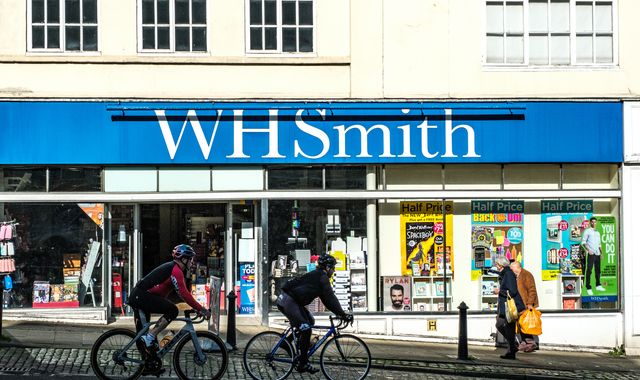The £76m deal will see its 480 high street stores rebrand as TGJones, under the ownership of Modella Capital, which won the final stage of the auction process.
While WH Smith has given up its high street business, it will continue its lucrative travel retail arm, with 1,200 stores, based mainly at airports and railway stations, in 32 countries globally.
But its erasure from UK high streets marks the end of an era stretching back to 1792, when the first WH Smith was opened by Henry Walton Smith and his wife Anna in Little Grosvenor Street, London.
Here’s a look at some of the other high street giants that have disappeared in recent years.
Debenhams
Department store chain Debenhams, like WH Smith, was a staple of British high streets for centuries, first opening its doors in 1778.
But its remaining premises closed permanently in May 2021 after the company collapsed amid the fallout of the COVID-19 pandemic.
The retailer, which employed 20,000 people pre-pandemic, was already struggling before the outbreak, as shoppers moved away from traditional department store models and moved online.
However, it could not cope with the enforced closure of sites during lockdown and quickly went into administration within weeks of the virus fully hitting the UK.
Debenhams was acquired by fashion retailer Boohoo before the stores closed, and has been transformed into a successful online-only operation.
It’s so successful that Boohoo, in the midst of a huge fall in profit, has renamed itself Debenham Group.
Its chief executive Dan Finley said that a turnaround of Debenhams was now complete and the online department store’s updated business model now accounted for the majority of group profitability.
Woolworths
Once another high street fundamental, Woolworths – known for its pick ‘n’ mix, homeware and everything in between – had more than 800 stores in the UK at its peak.
The first store opened in November 1909 in Liverpool, by New Yorker Frank Woolworth, who had already established the brand in the US.
But almost exactly 100 years later – 6 January 2009 – its famous stores closed for good, just months after the company sunk into administration.
Analysts blame its downfall on a toxic combination of low cash reserves, lost credit insurance and crippling debt – all exacerbated by the 2008 financial crisis.
The stores were popular right until the end, with the firm’s final annual report showing a slight pre-tax profit in 2007.
But it was not enough to save the struggling business, which left 27,000 people out of work.
Paul Seaton, who had worked as a store manager and as part of the IT team during 25 years at the company, told Sky News: “The sad reality is Woolworths took 99 years to build, and it took 42 days from administration to the day the last door shut. Ninety-nine years of meticulous care and thought… gone.”
Ted Baker
Founded by Ray Kelvin in Glasgow in 1988, Ted Baker went on to become a popular menswear label across the UK and ventured into womenswear, too.
But a torrid period began for the retailer in 2019 when Mr Kelvin left amid claims of inappropriate behaviour towards colleagues.
It was subsequently forced to issue a string of profit warnings and accounting mishaps, having to address the COVID-19 pandemic from a position of financial weakness.
In 2020, it axed hundreds of jobs and raised £100m to shore up its balance sheet.
Ted Baker was delisted from the London stock market in 2022 after being bought by Authentic, headed by the entrepreneur Jamie Salter, for about £210m.
But it never recovered, eventually closing 15 of its UK stores in early 2024, before closing its remaining 31 shops in August 2024.
Just before closing all stores, owners Authentic struck a deal with United Legwear and Apparel Co (ULAC) to operate an e-commerce presence for the brand in Britain and Europe, so Ted Baker still has an online store.
Arcadia brands
The Arcadia Group, led by Sir Philip Green, employed around 13,000 people across its high-street fashion brands like Topshop, Topman, Burton, Dorothy Perkins and Miss Selfridge.
After nearly two decades, the empire came crumbling down when Sir Philip was forced to put the group into administration in the autumn of 2020.
It was picked apart by online retailers, with Asos swooping in for big names like Topshop, Topman, Miss Selfridge and HIIT, and Boohoo taking over Burton, Dorothy Perkins and Wallis.
Arcadia’s downfall was one of the most spectacular implosions in recent corporate history, forcing about 500 standalone sites to close.
Sir Philip bought the high street group in 2002 for £850m, and just three years later paid what remains one of the largest-ever dividends – £1.2bn – to his wife and Arcadia’s registered owner, Lady Tina Green.
Arcadia’s collapse came in the midst of the pandemic, but its downfall occurred after many controversial moves by Sir Philip.
BHS
BHS – or British Home Stores – collapsed into administration in April 2016, leading 11,000 workers to lose their jobs.
The brand, established in 1928, closed its last 22 stores in October 2016.
Sir Philip Green also owned BHS after buying it for £200m in 2000. He sold the business to Dominic Chappell, a serial bankrupt, in 2015 for £1.
Twenty-two thousand pensioners were hit by a £571m black hole in the collapsed retailer’s pension fund, leading MPs to push for Sir Philip to be stripped of his knighthood.
He eventually paid £363m to settle the pension schemes, while Chappell was jailed for six years in 2020 for failing to pay tax on £2.2m in income he received after buying BHS.






























